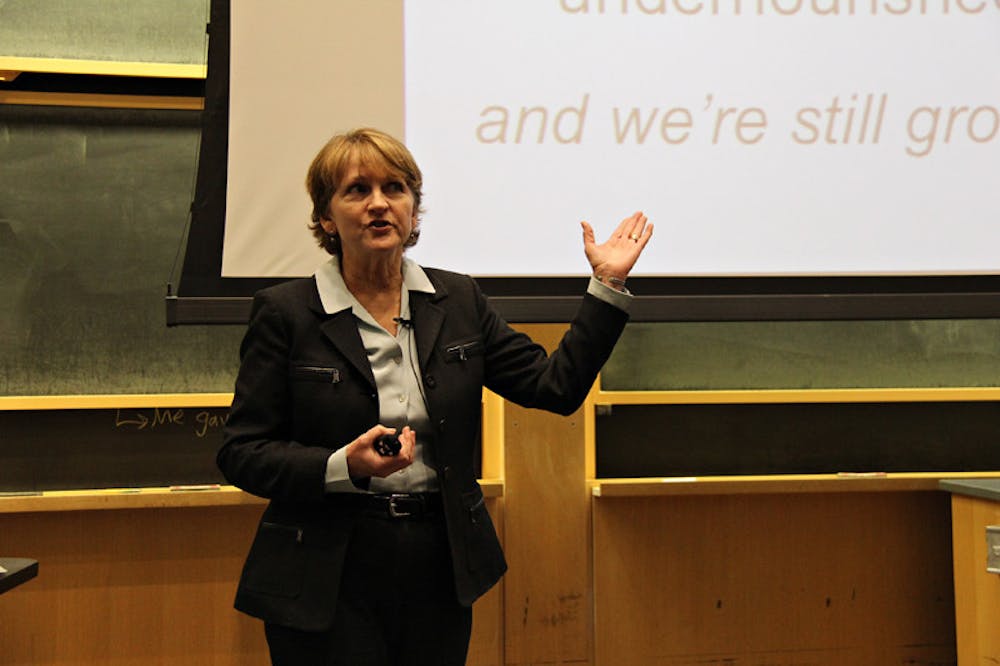The most critical challenge of the 21st century is maintaining systems that support life for many generations while meeting the needs of today’s population, said Pamela Matson, dean of the School of Earth Sciences at Stanford University, in a lecture yesterday.
Matson’s talk, entitled “Transitions to Sustainability in Agriculture: Ecosystem Science Meets Sustainability Science” and held in MacMillan Hall’s Starr Auditorium, discussed the controversial relationship between agriculture and sustainability. Her lecture was jointly sponsored by the Department of Ecology and Evolutionary Biology, the Department of Geological Sciences, the University’s Environmental Change Initiative and the ADVANCE Program.
“Our challenge for the future is to change the relationship in which meeting (human) needs has negative environmental consequences” to one where meeting needs can also sustain the environment, she said.
Matson spoke primarily about the accumulation of nitrogen in the ecosystem, an issue she highlighted as important to today’s environmental studies. Ever since the Green Revolution — a period in the mid-20th century focused on advancing techniques to expand world agricultural output — food production has been efficient enough to support the human population, she said. But this boom in food production has also led to land conversion and a loss of biodiversity, she added. Matson said farmers regularly over-fertilize their crops to try to produce greater yields, but they only end up producing a surplus of nitrous oxide, a major greenhouse gas.
Matson described her own research in the Mexican Yaqui Valley over the course of two decades. Along with an interdisciplinary team that included economists, ecologists and soil scientists, she researched a way to achieve a win-win agricultural solution: reducing nitrogen fertilizer use while maintaining crop yields. Through field experiments and simulation models, Matson and her team eventually designed an ideal fertilizing plan by using almost half of the amount of fertilizer that farmers were regularly using, she said.
But reducing nitrogen fertilizer was hampered by influential credit unions and other organizations that prevented her group’s plan from being widely implemented, she said. Credit unions would often support farmers only on the condition that they continue to use excess amounts of nitrogren fertilizer because they wanted to ensure adequate crop yields, she added.
“(We learned that) if you really want your knowledge to be used, you have to actively engage in making that happen,” Matson said. “You have to understand who the decision-makers are, and you have to engage in that knowledge system.”
Matson described a process she called the “pipeline model of knowledge transfer,” in which academics assume the recommendations from their research will be immediately implemented. But this system does not usually work, she said, stressing the importance of two-way dialogue between researchers and decision makers.
“You really want to identify ‘bridgers’ — boundary organizations, individuals and objects that bridge the cultures between scientists, science and decision-making worlds,” she said.
Matson expressed optimism in the scientific progress regarding reduction of fertilizer use. A win-win solution is possible, given that communities are already transitioning to more sustainable agricultural practices, she said. She ended her presentation with a slide depicting an image of Earth from space, with the word “imagine” hovering over it.
“Universities are making a big difference, talking about (sustainability) but also living it and carrying out research to move us in this direction,” she said.
Many audience members, who were mostly students, used the question and answer session that followed the lecture to express their interest in the topics Matson discussed.
“I really liked the way she addressed communication between organizations and communities,” said Walter Kikuchi ’16, who attended the lecture with his first-year seminar class SOC 0300L: “Environment and Society in Africa.”
“I thought it was really great,” said Kailani Acosta ’16, who currently works in an environmental science lab. She added that she took a course in environmental science last semester and thought Matson’s lecture “tied everything in really well.”

ADVERTISEMENT




